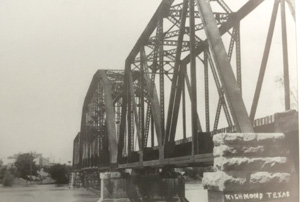A LITTLE PIECE OF HISTORY | By Joan Frances –

Richmond locals gather on the GH&SA railroad bridge to have a look at the floodwaters of the Brazos River during the flood of 1899. Flooding along the Brazos continues to be a problem, which created the need to develop a system of levy districts along its banks to protect developments in the area from the rising floodwaters when they occur.
When Fort Bend County was established in early 1837, a log fort built at the bend of the Brazos River, known as the nucleus of the settlement, set progress in motion. Transportation was the key to commerce and development. Natural animal crossings guided the tra-velers across the terrain. Horses, wagons, boats and rafts made passage a little easier. In 1854, with the construction of the railroad, joining the land through the rivers became imperative. Historic wooden truss bridges were built to connect both communities and people.
A truss bridge is a superstructure of connected elements forming triangular units. They are pin jointed, where the straight components meet, and made to support the weight of railroad, animal and moving traffic. They are one of the oldest types of bridges, constructed of wood and metal, and many have sustained the test of time. The Brazos River, called Rio de los Brazos de Dios (The River of the Arms of God) is the longest river in Texas, and the 11th longest river in the Unites States. It travels 840 miles before emptying into the Gulf of Mexico.
The Buffalo Bayou, Brazos and Colorado Railway tracks reached the east bank of the Brazos opposite the town of Richmond in December of 1855. At that time, a bridge was too expensive and took too much time to build. For the Brazos River to be intersected, a temporary bridge, six feet above the water line, was devised that provided for a large flatboat, moored under the center span, to move it out of the way, allowing for river traffic to pass. When the temporary bridge was out of service, the

A view of the Galveston, Harrisburg and San Antonio (GH&SA) bridge, believed to be around the time of the 1931 flood, was taken from the eastern bank of the Brazos River. The city of Richmond can be seen in the distance. Photos from Railroads of Fort Bend County.
public ferry was used. The ferry continued in operation until 1887 when Richmond was given a collapsed bridge from Waller County. It was connected and opened. On August 3, 1893, a herd of cattle driven across caused the middle span to collapse. A year later, the city erected a new Brazos River bridge with a 420-foot main body and wooden trestle approaches. The new bridge ended on the west bank of the river at Commerce Street. Unfortunately, the Brazos River is unrelenting, as history continued to repeat itself. In December 1913, a flood took away about 80-feet of the west approach and approximately 70 feet of the east approach, leaving the main bridge span between the piers isolated. Then, in the Spring of 1922, flooding caused the collapse of the center span of the Brazos River bridge, and once again, the only means of crossing the Brazos at Richmond was by ferry.
In 1925, a bridge was constructed over the Brazos River on US Highway 90A. This was a significant success for many reasons. It was the first highway bridge in the State of Texas to use the pneumatic (compressed gas) method of pier construction. At the time of assembly, the piers, which were 119 feet bottom to top and extended 30 feet below sea level, were the highest masonry piers constructed in Texas. The Richmond bridge was also a significant connection to the state and national highway systems. Known as part of the “Old Spanish Trail,” the main artery between Houston and San Antonio was State Highway No. 3 (now US 90A). In 1924, the State Highway Department predicted that once the bridge was completed and traffic commenced, this road would develop into one of the heaviest traveled thoroughfares in the south.
Today, residents of Fort Bend County can appreciate and admire the remarkable technology in truss bridges. They will continue to productively connect communities and commerce for many years to come.